Quintessential Toronto Maple Leaf goes to great ice rink in sky
Aug 16th, 2009 | By Dominic Berry | Category: Sporting LifePresent-day fans of the Toronto representatives in the National Hockey League will find it inconceivable. But Ted “Teeder” Kennedy, “perhaps the quintessential Maple Leaf” (or just “quintessential Leaf“), played centre for only 14 seasons in the 1940s and 1950s, and was actually “PART OF FIVE STANLEY CUP VICTORIES.”
Alas, the hockey-star Ted Kennedy of the great north “died of heart failure yesterday [Friday, August 14, 2009] at 83 in a Port Colborne [Ontario] nursing home.” What I remember best about him myself was that he spoke at my 30th Toronto Cub pack father-and-son banquet in 1953 – or maybe it was 1954 or even 1955.
Like every other young man at the banquet I shook hands with Teeder at the end of his talk. (“What did he talk about?” my wife asked me last night. I have no idea. Probably it had something to do with good sportsmanship?)
Long ago one of my valued possessions was an autographed photo of Ted “Teeder” Kennedy, which I received when I shook his hand. Just when or how I lost this I can’t remember. But I haven’t seen it for years now.
“Come on Teeder” at Maple Leaf Gardens
I also remember attending at least a few of Ted Kennedy’s games at the then legendary Maple Leaf Gardens on Carlton Street, just east of Yonge.
My father occasionally got tickets at his place of work – and played as well in one of the local militia bands that periodically entertained between periods in those days now long gone by.
Like many, many others, I can remember hearing the equally legendary John Arnott, who shouted “Come on Teeder … from the green seats in quiet times during Leaf games,” in a unique booming voice that echoed throughout the Gardens.
(In the interests of comprehensive cultural anthropology, I should clarify that the Maple Leaf Gardens seats of the day were, from most to least expensive, reds [or “Boxes and Rails”], blues, greens, and greys. I.e., John Arnott sat in the second least-expensive “green seats.”)
Ted Kennedy as quintessential Toronto hockey hero
I remember Teeder Kennedy too because, when I tried to play hockey myself, people would sometimes tell me that I skated like him. Which was just another way of saying that I didn’t skate very well at all. And this, I think, raises some interesting home truths about both Toronto (even today?) and the man who probably does qualify as the “quintessential Maple Leaf.”
According to linemate Howie Meeker, e.g., Teeder “wasn’t a skater, didn’t have the legs.” Jean Beliveau, great star of the rival “Montreal Les Canadiens” (as a Toronto newspaper ad of the 1940s put it) elaborated: Ted Kennedy’s “skating was not 100 per cent.” But he “certainly compensated with his great want to win, to do things right.” Or as the Bee Hive Corn Syrup hockey website explains today: “Teeder was a poor skater, but his hard work ethic and competitive spirit made him one of the most outstanding centres and leaders in NHL history.”
Kennedy, who was Leaf captain from the late 1940s to the mid 1950s, was a particular favourite of Conn Smythe, the local sand and gravel entrepreneur (“C. Smythe for Sand”), who owned and/or managed both the Toronto Maple Leafs and Maple Leaf Gardens. And Mr. Smythe summed up Teeder’s virtues this way: “Ted Kennedy was not a superbly gifted athlete the way some players were, but he accomplished more than most of them by never playing a shift where he did not give everything he had.”
This, you might say, was the kind of man the old Toronto establishment liked most. Teeder was not at all the best in his business. (“In 1998, he was ranked number 57 on The Hockey News‘ list of the 100 Greatest Hockey Players.”) But, to cite linemate Howie Meeker again: “He was tough as nails and there’s never been a harder worker in every game … You would be ashamed if you didn’t go out and work as hard as he did. He was never I or me, it was always we or us.”
Teeder had too, it would seem, the respect for the concepts of ancient hierarchy which still attracted men like Mr. Smythe, in the old Toronto that was still a proud outpost of the old British imperial civilization in North America.
There is a photo of Ted Kennedy meeting the then Princess Elizabeth on a visit to Maple Leaf Gardens in 1951 – the year before she became Queen in the United Kingdom across the pond (and the year before Louis St. Laurent appointed Vincent Massey the first Canadian-born Governor General of Canada). Teeder has a look of reverent reticence on his face as he almost bows to the young princess. Meanwhile Conn Smythe looks on proudly – this is the kind of hero we make for the empire here, etc, etc.
Teeder’s career on ice: a very short history
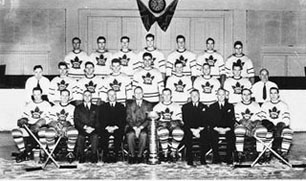
Stanley Cup champions 1945: “Young Teeder Kennedy leads the way with 7 goals, including 4 in the final series.”
From quite early on, it also seems, Teeder’s never-been-a-harder-worker-in-every-game ethos took its toll on him physically. Helped along by the domestic labour shortages of the Second World War, he started with the Leafs at the tender age of 17 in the 1942-43 season, when he played only two games.
He played 49 of a total 50 games in 1943-44 and 1944-45 (and won his first Stanley Cup in 1945 – Toronto’s way of helping celebrate the imminent end of the second great war overseas). But he played only 21 games in the 1945-46 season.
In the late 1940s there were 60 regular season NHL games. Teeder played all 60 in 1946-47 and 1947-48, and 59 in 1948-49. And he helped the Leafs win three Stanley Cups in a row in 1947, 1948, and 1949.
Then in 1949-50 there were 70 regular season NHL games, but Ted Kennedy played only 53. Like 1945-46, this was a hint of things to come. Teeder nonetheless managed as many as 63 of 70 games in the 1950-51 season – his best ever statistically (18 goals and 43 assists for 61 regular season points, placing him sixth among NHL scoring leaders). And he nicely wrapped up 1950-51 with his last Stanley Cup.
From here Kennedy managed a full 70 games and 52 points in 1951-52. But he only played 43 games in 1952-53. He was back to 67 games in 1953-54. In 1954-55 he played a full 70 games and “was named Hart Memorial Trophy winner as league most valuable player.”
Yet 1954-55 “was a season that almost never happened … Beset by injuries, Kennedy was leaning toward retirement but was talked out of it by … Conn Smythe. A contemporary newspaper account … indicated Smythe was giving Kennedy a raise above his $25,000 salary … The MVP season would essentially be Kennedy’s last as his body broke down. He missed the next season and played 30 games in 1956-57 before retiring for good.”
After the NHL …
Teeder was only 32 when he retired for good in 1957. This was still an age when NHL players made nothing like the kind of money they make today. (Though $25,000 a year was certainly an excellent ordinary salary in the mid 1950s, to say nothing of the last raise above this that Conn Smythe finally gave to his favourite player.) Ted Kennedy had not saved or made at all enough money during his 14-year professional hockey career to retire to a life of leisure.
Teeder tried a career in hockey management, but it didn’t work out: “In 1957—58, he was the second coach of the Peterborough Petes OHA ‘Junior A’ team, and like his predecessor, Calum MacKay, lasted just one season.”
He then returned to Port Colborne, Ontario (in the Niagara region) where he was born, and “put in a long stint in the trucking business.” (The Beehive Corn Syrup hockey website says that Ted Kennedy was “Born in Humberstone, Ontario in 1925.” But this is just, as it were, a suburb of Port Colborne, which is on Lake Erie at the southern end of the Welland Canal.)
After his long stint in the trucking business, Kennedy who was “a devotee of thoroughbred racing … opened and operated a thoroughbred training centre at St. Marys, Ont., where horses were stabled and trained during the off-season and injury recuperation periods.” He “then worked for the Ontario Jockey Club for many years as a steward and director of security at the Fort Erie race track near his Port Colborne home.”
He was also (and aptly enough) “named to the [Hockey] Hall Of Fame in 1966.” And he and his own Toronto idol Syl Apps “were the first Leafs to have ‘honoured numbers.’ Their 9 and 10 were raised to the Gardens roof in 1993 and now adorn the Air Canada Centre.”
I can’t really say that Teeder was any great idol of mine, or has played any major part in my own obscure existence. But he was certainly a legend of my Toronto childhood. I actually did shake his hand once. And I was quite sad to hear of his death in Port Colborne at the age of 83, on August 14, 2009. (He “is survived by his wife Doreen, son Mark, two grandchildren and two great-grandchildren.”)
I like to think I and many others like me have grown at least somewhat beyond the world Conn Smythe helped create north of the North American Great Lakes, back in the 1930s, 1940s, and 1950s. But I still have some admiration and certainly respect for the “quintessential Leaf” virtues that Ted “Teeder” Kennedy personified so well – “tough as nails and there’s never been a harder worker in every game … You would be ashamed if you didn’t go out and work as hard as he did. He was never I or me, it was always we or us.”
I have never been a real Toronto Maple Leafs hockey fan either. But I do remember that the Leafs went on to win four more Stanley Cups in the 1960s, after Teeder retired. And I am certainly aware that they subsequently haven’t won the Cup since the centennial of the Canadian confederation in 1967 – now a full 42 years! They could no doubt use some of the virtues of the quintessential Maple Leaf … if only someone knew how to get some updated version of them back for the early 21st century. Meanwhile, people as old as I am will remember when John Arnott used to boom out “Come on Teeder,” from his perch in the second least-expensive green seats at Maple Leaf Gardens. Those were the days, etc, etc, etc.
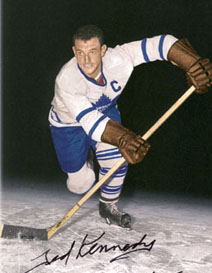
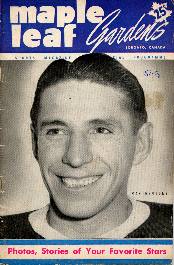
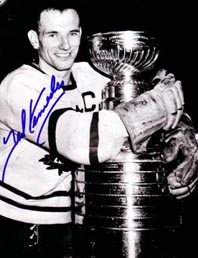
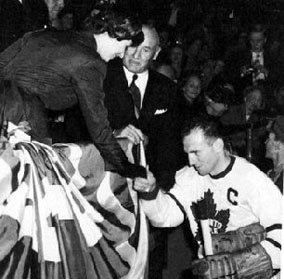
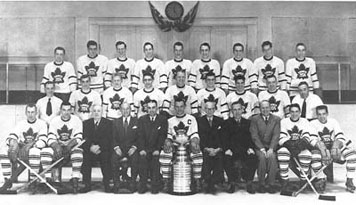
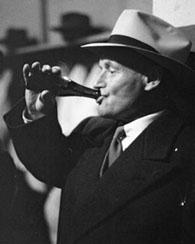
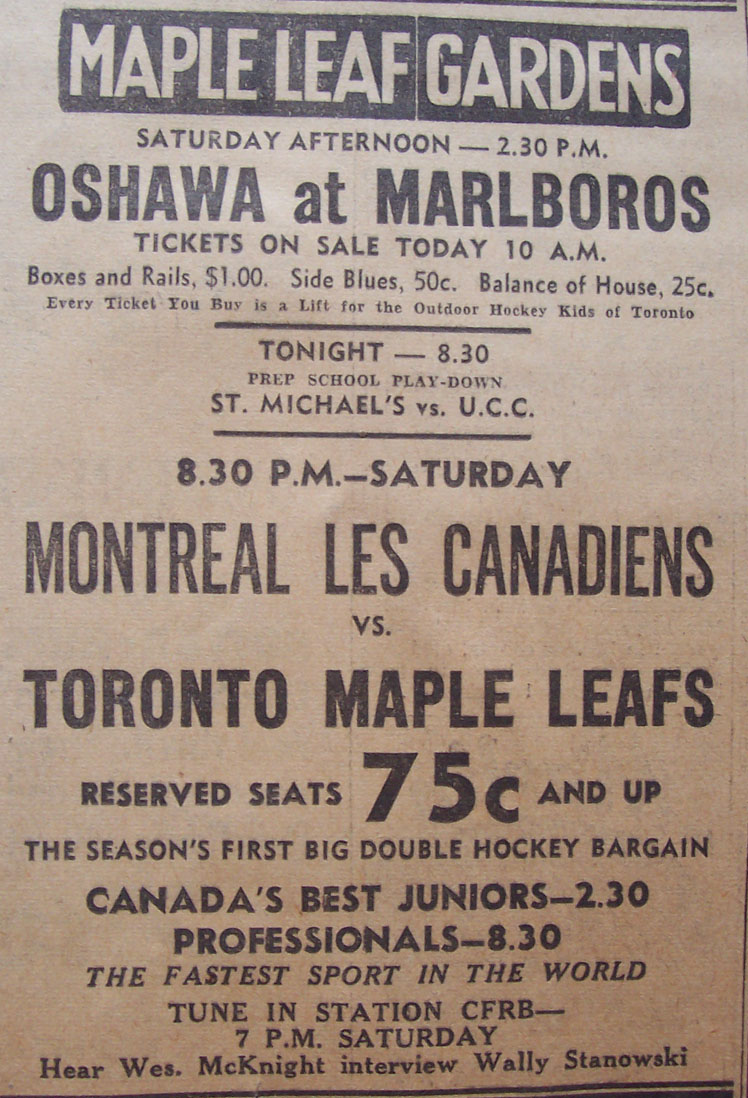


“Teeder was my favourite player–great bio on him—i also remember very well “arnott,’s
famous chant at the games when listening to games on radio–then on limited periods on
the televison—i am still a leaf fan since 1948—–newer fans hopefully will see them win the
cup although the big difference now is there are 30 teams involved not “6”
–GO LEAFS GO——Shirley potter